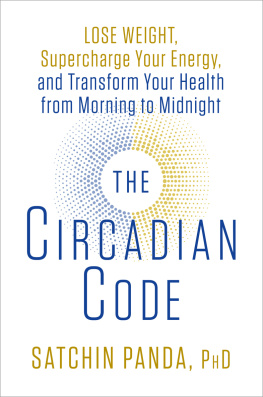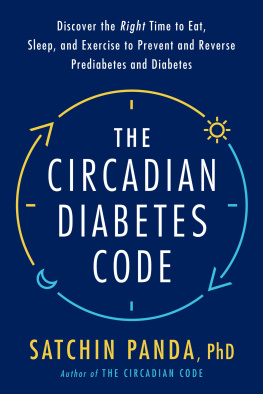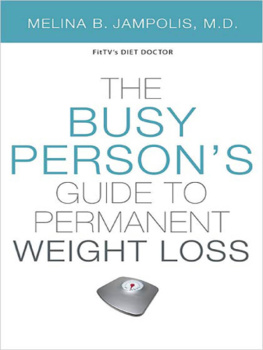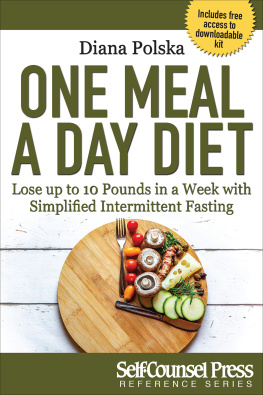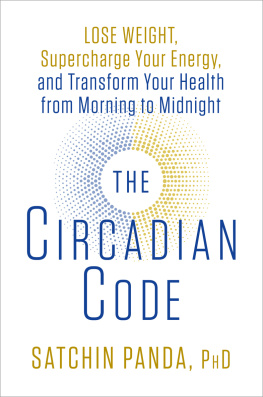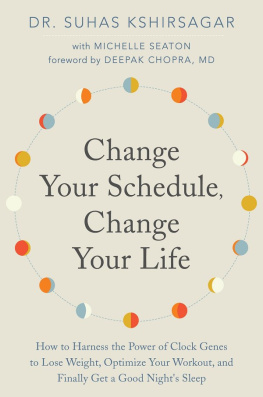
Copyright 2018 by Satchin Panda, PhD
All rights reserved.
Published in the United States by Rodale Books, an imprint of the Crown Publishing Group, a division of Penguin Random House LLC, New York.
crownpublishing.com
rodalebooks.com
RODALE and the Plant colophon are registered trademarks of Penguin Random House LLC.
This book is intended as a reference volume only, not as a medical manual. The information given here is designed to help you make informed decisions about your health. It is not intended as a substitute for any treatment that may have been prescribed by your doctor. If you suspect that you have a medical problem, we urge you to seek competent medical help.
Library of Congress Cataloging-in-Publication Data is available upon request.
ISBN9781635652437
Ebook ISBN9781635652444
Illustrations by Satchin Panda, PhD
Cover design by Amy C. King
v5.3.1
a
To my loving grandparents,
Banchhanidhi and Urbashi Panda,
Kalpataru and Leelabati Otta
Contents
Preface
To have rhythm, to be in sync, is to be healthy.
But not just any rhythm will do.
Germ theoryand its related breakthroughs of sanitation, vaccination, and antibioticswas the groundbreaking health development of the past century. It prevents infectious disease and led to the most dramatic rise in longevity in any century in human history. Yet living longer does not always mean living healthier. In fact, we are now witnessing a rapid increase in chronic diseases of both the mind and the body beginning in early childhood and stretching through old age. Luckily, we are beginning to understand the cause: Our modern lifestyle is disrupting a deeply ingrained, primordial, and universal code to being healthy.
The observations that I have made over the past twenty years, along with my colleagues and other researchers in the tiny field of circadian biology, are radically changing the way we understand how both the body and the mind optimally function. The science of circadian rhythms is actually a multidisciplinary field that includes biologists, exercise physiologists, mathematicians, psychologists, sleep researchers, nutritionists, endocrinologists, ophthalmologists, geneticists, oncologists, and more. Working together, we have found that simply adjusting the timing of how we liveand making easy lifestyle changesis the secret to restoring our rhythm, and it will surely be the next revolution in health care. I invite you to learn what I have uncovered through my own research and through working with the best minds in each of these fields. I call this the circadian code, and by adopting these lessons you will make small changes to the way you sleep, eat, work, learn, exercise, and light up your home that will make a profound difference in every aspect of your health. In fact, the benefits youll reap can be far more effective and long-lasting than any medication or special diet.
You may have heard about circadian rhythms before; a 2017 Nobel Prize recognized this field of research for its impact on human health. But if you havent heard of circadian rhythms, dont worry; the concept is very simple. The term circadian comes from the Latin circa, meaning around (or approximately), and dim, meaning day. Circadian rhythms are real biological processes that every plant, animal, and human exhibits over the course of a day. These rhythms are actually interconnected among species and are governed by internal circadian or biological clocks, which are very different from the ticking biological clock you might think about if youre worried about having kids by a certain age. As youll learn, almost each and every one of our cells contains one of these clocks, and each is programmed to turn on or off thousands of genes at different times of the day or night.
These genes influence every aspect of our health. For instance, when we are healthy, we can have a good nights sleep. In the morning, we wake up feeling fresh and energetic and ready to get to work. Our gut function is perfectly normal. We have a healthy hunger and a clear mind. In the afternoon, we have the energy to exercise. At night, we are tired enough to go back to sleep without much effort. Yet when these daily rhythms are disturbed for as little as a day or two, our clocks cannot send out the right messages to these genes, and our body and mind will not function as well as we need. If this disruption continues for a few days, weeks, or months, we may succumb to all types of infections and diseases, ranging from insomnia to attention deficit hyperactivity disorder (ADHD), depression, anxiety, migraine, diabetes, obesity, cardiovascular disease, dementia, and even cancer.
Luckily, its easy to get back in sync. We can optimize our clocks in just a few weeks. By restoring our circadian rhythms, we can even reverse some of the diseases or accelerate cures, returning us to better health.
My Journey: Discovering the Secrets of the Biology of Time
I was lucky to be born (in 1971) and raised in India during a unique time in history. I experienced firsthand how a rapidly evolving modern society disrupts the interconnectedness of life, including our own biological rhythms. Throughout my early childhood, I lived in a small town near my maternal grandparents. My grandfather worked as a goods clerk at the local train station, where he often worked the night shift. My grandparents lived in a house with a large jasmine tree near their front gate. To me, that tree was magical: It bloomed profusely at night and would shed its flowers right before dawn, as if laying a beautiful carpet to welcome my grandfather home each morning.
During summer and winter breaks, we visited my fathers family, who lived on a farm in a rural part of the country. The contrast between my maternal grandfathers shift work at the train station and my paternal grandfathers life on the farm, in sync with nature, seemed like it was at least a century apart, although it was only a 2-hour road trip to get from one place to the other. For most of my childhood their village did not have electricity, so as you can imagine, life on the farm was very different from life at my home. My relatives raised almost everything they ate. Although I dont remember my grandfather ever wearing a watch, their daily routine happened with clockwork precision that was in sync with the sun and the stars. At the crack of dawn roosters sounded the alarm clock that woke everyone up. The whole day was spent tending to plants and animals and preparing meals. We picked fruits and vegetables or helped my uncle catch fish from the farm pond. Breakfast and lunch were the main meals, and they were feasts prepared with freshly picked vegetables and fish. Dinner was always before sunset and was mostly leftovers from lunch, as it was impossible to store any cooked food overnight. The evenings were also very different. The only light we had available came from kerosene lanterns. In those days kerosene was expensive and rationed by the government. My grandparents had a relatively large house with six bedrooms. We were only allowed to use the lanterns for a couple of hours in the evening, except for two lanterns that were placed at the ends of the verandah that flickered all night. After dinner all of the kids would huddle around a lantern, and my motherwho was a schoolteacherwould quiz us. Sometimes our aunts would join to tell us stories or my uncle would take us to the backyard to teach us the phases of the moon.
I remember asking for certain fruits or vegetables I liked to eat at home and being met with a strange look from my cousins. To them, I was a dumb town kid who didnt know which fruits and vegetables grow in what season. But what they didnt know was that my father, who had a college degree in agriculture, had introduced many high-yielding trees, vegetables, and rice varieties to my grandfathers farm. Some of these new rice strains could even grow in both the summer and winter, essentially doubling the return from the same piece of land. In this instance, disrupting the natural order of things didnt seem like such a bad idea.
Next page
